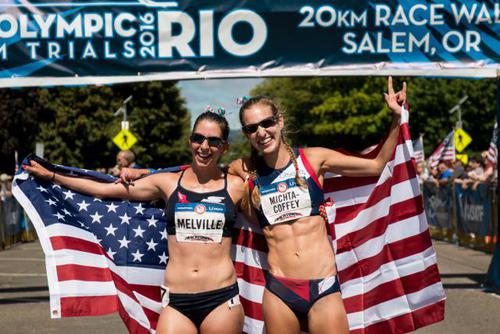 Miranda Melville and Maria Michta-Coffey, photo by Dillon Vibes
Miranda Melville and Maria Michta-Coffey, photo by Dillon Vibes
The 20k Race walk is nearly 90 minutes of physically draining effort. Consider this, running 20k at 8 minites or better pace, and having to keep your form! While the history of racewalking is rich globally, it is has its ups and downs in the US. Here is a fine story by Kylee O’Connor, her first story, in fact, for RunBlogRun. We thank her professor, Lori Shontz for developing the journalist program on track & field, which is supported by the University of Oregon.
By Kylee O’Connor
SALEM, Oregon – The United States doesn’t normally field strong teams in the race walk. But two women who had already reached the Olympic qualifying standard sealed their trip to the Rio de Janeiro Olympic Games on Thursday with a 1-2 finish at the U.S. Olympic track and field 20-kilometer race walk trials.
Maria Michta-Coffey, a 30-year-old from Farmingville, New York, and the American record holder, won in 1 hour, 33 minutes, 40 seconds. Her frequent training partner, 27-year-old Miranda Melville, a Rush, New York, native, followed shortly behind in a time of 1:34:11.
They were the only two who entered the event with the Olympic standard time of 1:36, and they were the only two to meet the standard again in the trials.
“I was very ecstatic, and there are no words to describe when you come through,” Melville said. “I think right now it’s just going to be floating on cloud nine and then getting down to business.”
Michta-Coffey and Melville ran side by side for around the first 30 minutes of the race. From there, Michta-Coffey gradually widened the gap between herself and Melville.
It is not uncommon for them to be walking partners. Both grew up in New York–a state that includes race walking in high school–and by competing together at higher levels, they have created a bond as they have emerged as the top female race walkers in the country.
Whenever there is an international competition, they do pre-camps together. Michta-Coffey recently stayed with Melville for a few weeks in January.
“We both admitted to each other, we saw the hug that Shalane [Flanagan] and Amy [Cragg] gave each other at the marathon trials, and we’re like, ‘That’s going to be us, that’s going to be us on June 30th,'” Melville said.
Growing up in one of a few states that include the race walk in high school, Michta-Coffey is passionate about the importance of including the event in high school competition. She noted that many of the younger spectators at the race had attended a youth camp run by competitor Erin Gray the day before. (Gray, who grew up in Eugene, Oregon, finished third at the 2012 trials but didn’t meet the Olympic standard, and this year she was disqualified.)
“Some of you kids that got introduced to this from Erin over the past few months or you got to meet us yesterday, you’ve got a head start on us,” Michta-Coffey told the crowd. “But for everybody else, take notice: when you do have race walk in the high school program, Olympians are possible.”
Michta-Coffey was a soccer player growing up and she went as far to say that she wanted to be an Olympic soccer player. If it weren’t for the race walk being introduced to her in high school, she says that she wouldn’t have the opportunity to go to the Olympics that she has today.
“As a freshman, you try every event–that includes the race walk in New York and I happened to be naturally good at it,” she said. “One thing led to another.”
There were dozens of kids lined up around the course cheering on the race walkers. Those kids are the potential race-walking Olympians that Michta-Coffey hopes to see in the future.
“If we can have a large group of people race walking at a younger age then we have more people in the future, we can get better and better people to pull from,” said Michta-Coffey, who has a Ph.D. in biomedical sciences. “The ultimate goal for U.S. race walking is to be in medal contention, to get on the podium internationally.”
Although Michta-Coffey or Melville have won dozens of national championships between the two, they have never placed in the top 20 at an international event. With more growth for the event of race walking at the high school level, they think there could be potential for the United States to become a greater competitor on an international stage.
“We have just about seven weeks now until Maria and I race in Rio, and we’re ready to keep showing them that the U.S. is going to keep moving up in the ranks of race walk and making it better,” Melville said.





















